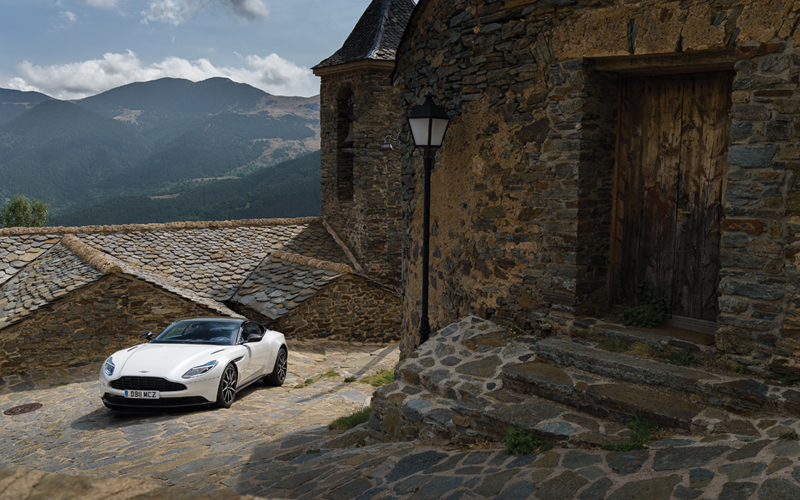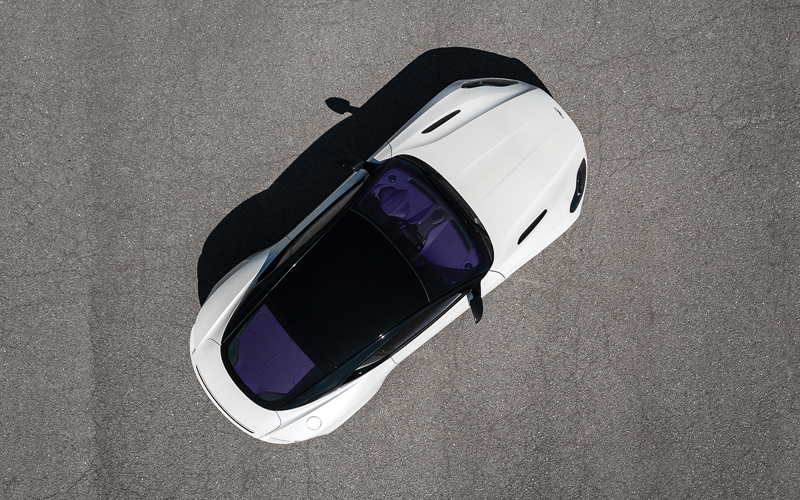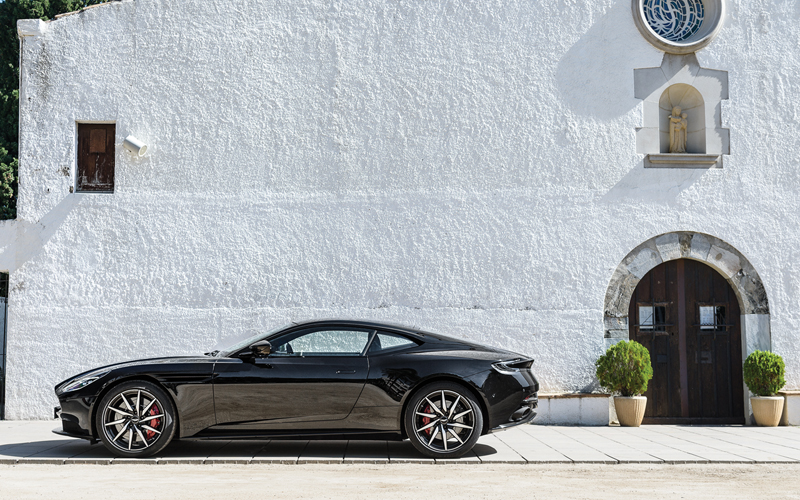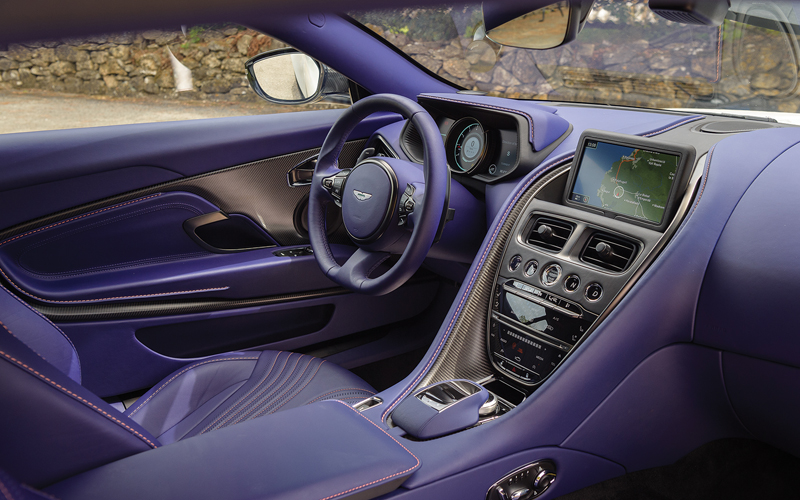_Under the refocused leadership of CEO Andy Palmer, a refreshed Aston Martin promises an all-out assault of new vehicles in the upcoming half-decade. The first out the gate was arguably its most important: the DB11. The V12-powered scion of the DB bloodline — one of the longest tenured and most esteemed grand tourers in automotive history — set the course for the next decade of the venerable British brand. Now Aston Martin transplants an AMG-sourced V8 under its sharply sculpted hood for a more lithe, agile DB11. Can downsizing ever be a good thing? _
Somewhere high in the foothills of the Pyrenees — in a pastoral valley tucked between the Spanish states of Catalonia and Aragon — the wail of an Aston Martin V8 being whipped into a frenzy echoes across the peaks. While the noise is deliciously violent — punctuated by loud cackles and barks as paddleshifters work their way up and down the eight-speed gearbox — it is pretty clear from this vantage point the Aston coupé is enjoying every second of the abuse.
As is the driver, which would be me. This sublime piece of hand-built British engineering and I are winding our way through La Faiada de Malpàs, a gorgeous slice of the Pyrenees high above a lake, on our way to the tiny village of Ventolà. There the famed Restaurant Anna beckons those seeking culinary delights from across Spain and France, and the gracious host awaits us with her charcuterie, tapas and signature duck, sweetly roasted with pears.
But all that can wait; I’m not really thinking about duck right now. I am 100% engaged with this totem of British performance, simultaneously flirting with its limits while desperately trying to keep all four wheels on asphalt. This is a vehicle you can most definitely steer with the rear axle — tease a bit too much throttle and the ass kicks out rambunctiously. And you will, pushing out of corners and getting your hips swinging just for goose bumps. For even more goose bumps — but considerably less traction control, a dubious prospect at these vertiginous heights — slip it into Sport+ and the twin cannon exhaust pipes snort even louder.
Praise mighty this 4.0-liter V8 sourced from the brainiac’s at Mercedes-Benz’s AMG performance arm (see sidebar). Tuned to generate 503-hp and 498 lb-ft of torque, it’s the same superb twin-turbocharged lump found in the AMG GT, as well as all of AMG’s “63” offerings. Although the engine is German, the exaltation it sings into the Spanish sky is much different than that found on a Merc — instead of the guttural bass that Affalterbach prefers, Aston Martin engineers pitched the engine to wail in mid to high notes. It just sounds like a classic Aston.
I’m having so much fun up in these Catalan hills that I begin to wonder: is it possible this V8 DB11 is the ideal DB11? We’ve experienced the V12 before, and it was a beast. Could it actually be that a smaller engine is a better application in this coupé than the hell-raising 12-cylinder?
In the Supercar Arms Race we are currently living through — where Dodge-branded muscle cars are eclipsing 700 horsepower, electrified Ferraris and McLarens are creeping towards quadruple digits, and even Teslas are shredding the 3-second mark to 60 mph — the idea of downsizing seems, well, quaint.
But downsizing has its advantages.
The term Aston execs repeatedly drum for the V12-powered version of the DB11 is “intercontinental ballistic missile”, or ICBM. And the metaphor is apt. The twin-turbocharged V12, brimming with 600 horsepower and 300 extra pounds of heavy artillery, feels like a classic GT: comfy, low, built for destroying straights and swooping surf-like on long turns. And it is, perhaps most importantly, fast as all hell at the top end with a 200-mph ceiling and a 0-60 mph click of just 3.9 seconds.
But this V8-powered DB11 is more like a sports car, agile and well-balanced. The V8 feels decidedly lighter, more nimble. And that’s not just because of the more svelte V8 (253-lbs lighter), but also because of its placement: as the V8 is more compact (4.0-liter vs 5.2-liter), its center of weight sits closer to the firewall. The engine block doesn’t hang as much over the front axel and therefore doesn’t drive the nose of the DB11 down. Compare its 49/51 (front/back) weight distribution to the V12’s 51/49: the lighter front end noticeably erases much of the V12 GT’s understeer.
But there’s more. A litany of chassis improvements have been fitted onto the V8 frame actually making its suspension better than its more expensive stablemate. The rear subframe bushes have been stiffened, as have front and rear anti-roll bars. The result is less pitch and roll, keeping more of the tires’ contact patch planted on asphalt. Combined with the lighter weight and better mass distribution, all around the V8 DB11 simply has better footwork. All of these advancements will migrate to the V12 DB11 of course, just not until the 2019 model year. Sorry, early adaptors.
Soon we’re passing the ancient medieval hamlet of Doria — the highest village in all of Catalonia. The homes here were the destination of shepherds who centuries ago led their flocks in the summer months from Barcelona. The tiny church at the town’s heart seems lifted from a UNESCO postcard; all the rooftops are made entirely of stone slate layered like dragon scales. I ease up on the coupé’s throttle, slip the driving mode from Sport back down into GT and begin to enjoy the more relaxed manners of the DB11. The “GT” mode lives up to its name: the steering softens, the throttle loosens, and everything eases into a more casual sensibility.
The DB has long been a gentleman’s car, not a redline-pinned racer, and in that way the DB11 continues the heritage superbly. These winding lanes through the Pyrenees quickly remind you of how glorious a GT can be on open roads.
When we finally arrive in Ventolà we pull to a stop in front of Restaurant Anna and look down at the valley below. The moment of respite lets you breathe in the fine details of the interior. The cabin of an Aston has long been a defining characteristic of the brand, and one of the justifications for its lofty price tags. Here in the high-altitude light the hand-built nature of the British supercar comes to life at close inspection. Our tester is entirely surfaced in smooth purple leather, a fine grain of the cowhide playfully embellished by the violet hue of the dye. It is offset with a pink stitching, which may sound flamboyant but works wonderfully to the eye. The most striking interior element is the brogueing that runs up the spine of the seatbacks, and radiates out over the width of the leather headliner. Outside of Rolls-Royce’s “Starlight” headliner, whose 1,340 LED lights can be customized to emulate the sky on the night of your birth (yes, really), rarely have you seen a roof this well appointed.
The contrast stitching is applied expertly in the widening lines of the seat, running along the bottom and back pattern, crowned with an embroidered “DB11” on the headrests. The pink stitching can also be found on the sun visors, running atop the gauge cluster, surrounding the center stack, alongside the door panels and on to the armrest — which, incidentally, is activated forward or back via a power button, not by human muscle. That would be uncivilized.
It should be mentioned the hand-stitching is a thing of its own: each Aston Martin seamstress in Gaydon is so proud of their work they sign their name on the inside of the leather upholstery — much like the AMG engineers do with the engine under the hood, also built by hand. Except with Aston these signatures are hidden; it’s strictly a private satisfaction.
Finally, it is time for some duck, with perhaps a shot of Spanish café post-meal to alert the senses. The Grans Muralles red, sadly, will have to wait till we’ve returned to the ivy-covered Mas de Torrent Hotel far below, but that is all fine and well for now. The drive back down the Pyrenees in the DB11 will be intoxicating enough.
GLORY IN SHEET METAL
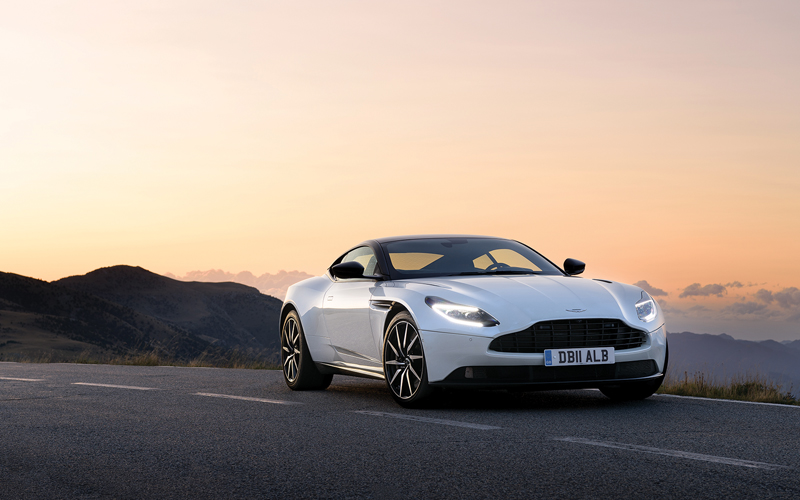
If there’s any single reason why Aston Martin has survived the past several decades of near insolvency it is because of its sheet metal. So, when we argue the DB11 is the most handsome Aston of the 21st century, that is saying a lot. Chief Designer Marek Reichman has taken the hereditary elements of Aston and dialed them all just a little more towards perfection, while keeping the proportions tight and somehow improving its cohesive message. This is a Grand Tourer, after all, so if it doesn’t crane necks then it doesn’t stand a chance in the market. But the DB11 is the sort of machine that demands silent contemplation from those in attendance.
The long hood, muscular haunches, angry LED headlights and sculpted panels of the Aston design language are second to none. But many of the DB11’s best visual flourishes can be attributed to Reichman’s team working closely with the aero engineers. Their work in moving air around the DB is simply astounding — not in tacking on ostentatious vents, air extractors and massive rear wings like on many supercars, but rather in cleaning up its lines for an elegant simplicity.
The nicest elements are the AirBlades, or hidden ducts that channel air through the C-pillars under the fender panels, and out through a vent over the taillights. Using internal airways to add downforce, these AirBlades eschew the need for an oversized rear wing.
WELCOME TO THE 21ST CENTURY

We can all thank the cosmos for the deal Aston Martin struck with Mercedes-Benz, surrendering 5% of their company in exchange for desperately needed electronic upgrades. And it’s not just the twin-turbo 4.0-liter V8 they nabbed from AMG — it’s in all things technology and entertainment. It starts with an 8” LCD screen for satnav, and a 12” TFT taking over the old analog gauges. There’s keyless entry, a Quiet Mode to start up the DB11 without waking finicky neighbors, and a dedicated camera button to scroll across different angles when parking to preserve your precious 20” rims. Daimler’s COMAND interface is surely the most critical electronic upgrade Aston Martin owners have pined for. Replete with control wheel and touchpad, COMAND finally drags Aston infotainment into the 21st century.
POWERTRAIN MODES
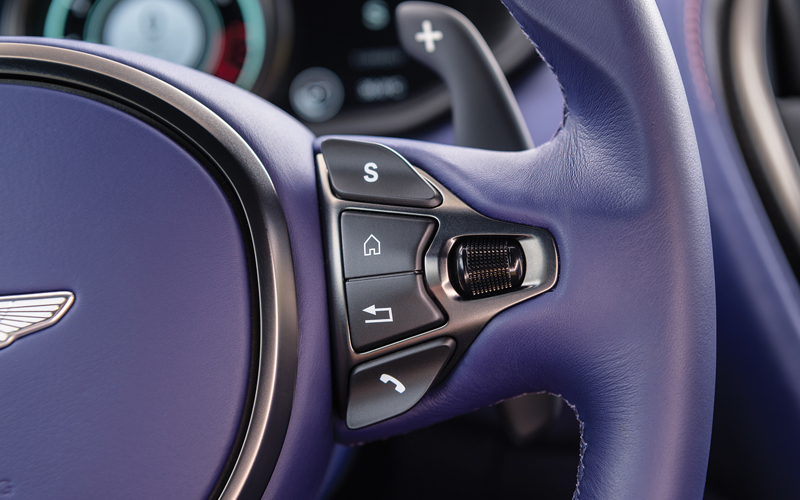
One of the most considerate aspects of the DB11 is the fact you can change powertrain and suspension modes separately via dedicated levers on the steering wheel. Each has three positions, so you can customize to your particular tastes: keep the suspension at its most compliant while dialing up throttle and transmission characteristics, or vice versa. Score points to Aston for this level of quick, intuitive customization.
Under the aptly named “GT” setting the DB11 glides over the road without trouble. Potholes are devoured without irritation, and hundreds of miles are passed with great pleasure. Switch to “Sport” mode and the suspension gets a bit tighter, but the car still retains its grand touring character.
Choose Sport+ and the GT turns a bit more diabolic. Exhaust flaps open, safety tech gets dialed way down, and you will thank the Supercar Gods. In both Sport and Sport+ the car will downshift repeatedly and very quickly under heavy braking to keep the revs up high, while in GT mode it will downshift more calmly and at lower revs. This really lends the different modes a strong differentiation.
GOING TOPLESS
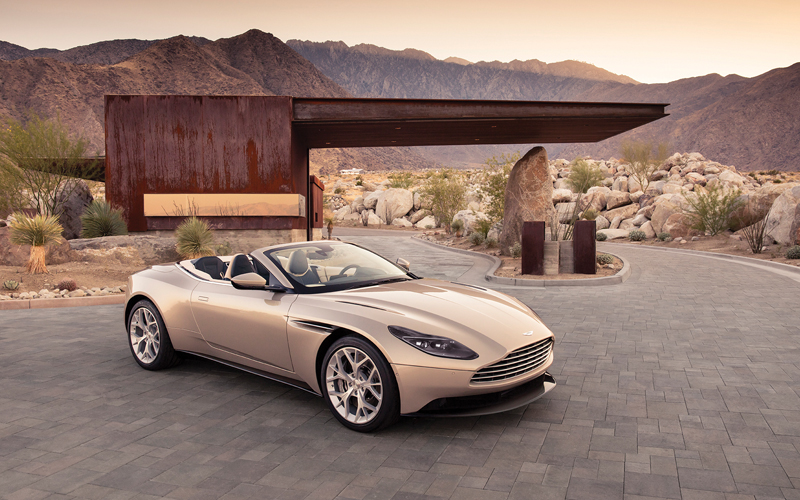
The hardtop coupé is a beautiful machine to witness, but Aston Martin just unveiled the open-roof version of the DB11: the Volante. In a surprise to many, the DB11 Volante will not be available with the 5.2-liter V12, but only with the AMG V8. Even more surprising is the Volante’s shapely profile: rarely are convertibles as attractive as their hardtop cousins. With the Volante, the droptop may be even better looking.

